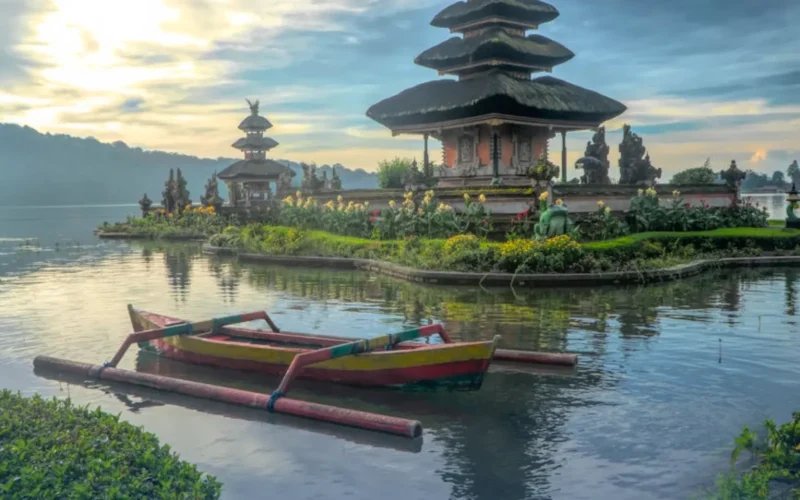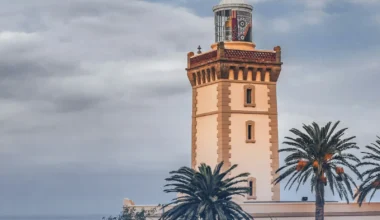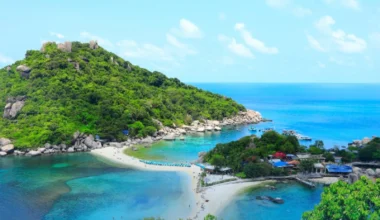Welcome to the enchanting Banggai Islands, one of Indonesia’s best-kept secrets. Nestled in Sulawesi, this destination offers a wealth of natural beauty, including the mesmerizing Paisupok Lake, pristine beaches, captivating caves, majestic waterfalls, and a vibrant wildlife scene. In this comprehensive travel guide, we’ll take you on an unforgettable journey through this hidden gem, making it accessible for independent travelers while also providing options for guided tours. Let’s embark on an adventure like no other!

Banggai Islands
The Banggai area in Sulawesi, Indonesia, is a well-kept secret, often overlooked by tourists. It comprises three different regencies: Banggai, Banggai Islands, and Banggai Laut. This makes planning a trip a bit more intricate than visiting other places in Sulawesi. However, the rewards are immense, and with the right guidance, you can explore this untouched paradise.
How to Get to Banggai Islands
Your journey to the Banggai Islands begins with a flight to Luwuk, a town in central Sulawesi. There are direct flights to Luwuk Airport (LUW) from Makassar in South Sulawesi or Manado in North Sulawesi. Alternatively, you can opt for an overland route to Luwuk from Ampana after visiting the Togean Islands, another beautiful destination in Sulawesi.
If you’re traveling from Bali, Jakarta, or elsewhere in Indonesia, you’ll likely have transit in Makassar or Manado on your way to Luwuk.
Taking the Ferry to Peleng
From Luwuk, you’ll embark on a fascinating journey to Peleng Island, your gateway to the Banggai Islands. The public ferry departs from Luwuk People’s Port (‘Pelabuhan Rakyat’) daily at 2 PM. The two-hour journey, although often delayed (a phenomenon known as ‘Indonesian rubber time’), is an affordable adventure, with tickets priced at approximately 54k Rupiah (~$3 USD) per person.
The ferry, a large wooden boat accommodating around 50 to 100 passengers, provides bunks and benches for seating. For added privacy, you can rent a small room for two with bunk beds and a fan for an extra 50k Rupiah per room.
Alternatively, consider arranging a speedboat to Peleng, offering a faster route to some of the island’s top attractions, including Paisu Pok Lake and Poganda Beach. This option costs more, ranging from 1.5 to 4 million Rupiah (~$100 to $250 USD) for a roundtrip with a private speedboat.
Whichever mode of transportation you choose, the sea between Luwuk and Peleng is usually calm, ensuring a smooth journey.
Overnight Stay in Peleng
Upon reaching Peleng, you’ll likely arrive in the late afternoon or evening. The stunning Paisu Pok Lake might tempt you, but it’s advisable to rest for the night. Novpitri Homestay, situated in Leme Leme by the harbor, offers basic accommodation with fans, squat toilets, cold water showers, and limited electricity from 6 PM to 6 AM.
While luxury is not the focus here, Novpitri Homestay provides a simple and comfortable place to recharge. Rates typically range from 120k Rupiah for a fan room to 180k Rupiah for an air-conditioned room. Advanced booking for the air-conditioned room is recommended.
If you prefer to stay closer to Paisu Pok Lake, Luk Panenteng village offers several basic homestays. Staying here provides easy access to the lake for daily swims.
Before retiring for the night, arrange a scooter rental from the homestay to explore the lake and beach the following day.
Day 2: Exploring West Peleng Island

Paisu Pok Lake
Your second day on Peleng Island begins with a visit to the breathtaking Paisu Pok Lake. This stunning blue lake is one of Banggai’s main attractions. You can rent a small boat, canoe, or stand-up paddleboard to explore the lake’s vibrant blue waters. Alternatively, take a swim or snorkel to immerse yourself in the incredible beauty.
Paisu Pok Lake is approximately a one-hour drive from Leme Leme, with some portions of the road requiring careful navigation due to potholes and road conditions. Despite this, traffic is minimal, making it easy to locate the lake.
The water’s mesmerizing blue hue is truly captivating and offers an unforgettable experience. Paisu Pok Lake is a photographer’s dream come true, and the reality is just as stunning as it appears in photographs.
Paisu Batango
A short drive from the lake leads to Paisu Batango, a picturesque lagoon known for its turquoise waters. Fed by a natural spring, the cold spring water maintains a beautiful turquoise color, even though it mixes with saltwater from the ocean. The name “Paisu Batango” translates to “trunk water” or “water from a tree trunk,” reflecting the lagoon’s unique source.
Sadly, some locals use this place for bathing and washing clothes with detergent, which can affect water clarity. Despite this, Paisu Batango remains a lovely spot for photographs, especially when viewed from above. Concrete stairways lead to the lagoon’s bottom, offering easy access.
Poganda Beach
Your exploration of Peleng Island continues with a visit to Poganda Beach, a tranquil white sand beach situated between Leme Leme and Paisu Pok Lake. Just a 30-minute drive from the lake, Poganda Beach is an idyllic destination for relaxation and snorkeling.
Surprisingly, the beach is home to numerous starfish, visible even without snorkeling. These delightful creatures can be found in shallow waters near the shore. Poganda Beach offers picturesque sunrises and sunsets, depending on the time of year. You’ll also discover swings and a pier, perfect for moments of relaxation and reflection.
After a day of sightseeing, return to Leme Leme and spend another night at Novpitri Homestay. The simplicity of the accommodations aligns with the island’s rustic charm.

Day 3: Caves & Salakan
Driving to the Caves
Day three begins with a journey to explore the fascinating caves of Peleng Island. Arrange for a driver to take you on this adventure, as the scenic drive involves hills, jungles, palm forests, and ocean views. The roads on Peleng are paved but broken in places, making a car a preferable mode of transportation.
The drive takes approximately five hours in total: two hours to reach the caves and an additional three hours to Salakan. While scooters are an option, it’s not recommended unless you have experience with challenging road conditions.
The best time to photograph the caves is in the morning, so starting early is essential. Arriving at the first cave, Gua Susendeng, around 9 AM is ideal.
Gua Susendeng
Gua Susendeng is the first cave on your itinerary, a shallow limestone cave with a high ceiling and a stunning blue pool at the bottom. A 10-15 minute downhill walk on a grassy path leads to the cave’s entrance from the main road.
While the descent is easy, the uphill return can be more challenging due to the absence of shade. Upon reaching the cave’s entrance, a concrete stairway leads down to the mesmerizing blue pool. The water’s color is remarkable, enticing you for a swim. Interestingly, scuba divers have explored this cave, discovering an underwater tunnel of at least 200 meters in length.
Gua Bab’banang
A mere 10-minute drive from Gua Susendeng takes you to Gua Bab’banang, your next cave exploration. A short 5-10-minute walk through the forest brings you to the cave’s entrance, where you’ll encounter blue-tailed lizards and vibrant green lizards.
Gua Bab’banang is a fantastic spot for photography, particularly when viewed from above. A concrete stairway descends to the cave’s bottom, revealing water even bluer than the first cave. While the cave itself is beautiful, it’s worth noting that a concrete bathroom has been built near the entrance, and litter can be found in the surrounding forest. Increased tourism may encourage locals to maintain this area more diligently.
Drive to Salakan
Following your exploration of the caves, embark on a three-hour drive to the charming town of Salakan. While you may plan to stop for lunch along the way, it’s advisable to wait and enjoy a late lunch in Salakan.
Day 4: Salakan to Banggai Laut
Bone Pompon Beach
On your fourth day in Banggai, arrange for a driver to take you on a picturesque journey from Salakan to various beaches and ultimately to the harbor in Tobing for your next adventure on Banggai Laut island.
The first beach on your itinerary is Bone Pompon, a 30-minute drive from Salakan. At Pompon, you can rent a small boat to explore hidden beaches, including the secret island of Pulo Tambun, known for its pristine white sand beach.
Bone Pompon Beach, with its crystal-clear waters and white sandy shores, serves as your gateway to the beauty of Banggai Laut island. Here, you can rent a small boat to explore hidden beaches, including the secluded Pulo Tambun with its pristine white sand beach.
Day 5: Exploring Banggai Laut Island
The Magic of Banggai Laut
As you step onto Banggai Laut island, you’ll be greeted by its unique charm and beauty. This island is known for its rich marine life, vibrant coral reefs, and captivating underwater scenery. It’s a paradise for snorkeling and diving enthusiasts.
Snorkeling and Diving
Banggai Laut offers some of the best snorkeling and diving spots in Indonesia. The waters here are teeming with colorful coral reefs and an abundance of marine life. Strap on your snorkel gear or scuba diving equipment and immerse yourself in the underwater wonderland.
Exploring Hidden Caves
Banggai Laut is not just about its stunning coastline; it also boasts hidden caves waiting to be explored. Engage in a bit of cave exploration and discover the secrets that lie beneath the island’s surface.
Day 6: Mbuang-Mbuang Island Adventure
Discovering Mbuang-Mbuang Island
Day six takes you on an adventure to Mbuang-Mbuang Island, a pristine and secluded paradise in the Banggai Islands. With its untouched beaches, crystal-clear waters, and lush greenery, this island is a haven for nature lovers and those seeking tranquility.
Relaxation and Exploration
Whether you choose to relax on the beach, take a leisurely swim, or explore the island’s interior, Mbuang-Mbuang offers a serene and unspoiled environment. It’s an ideal place to unwind and connect with nature.
Day 7: Return to Luwuk
Farewell to Banggai Islands
As your unforgettable journey through the Banggai Islands comes to an end, it’s time to bid farewell to this hidden gem. Return to Luwuk, where your adventure began, and take with you cherished memories of the natural beauty and warm hospitality of the Banggai region.

More Indonesia Travel Tips
Packing Essentials
- When packing for your Banggai Islands adventure, remember to include sunscreen, insect repellent, comfortable clothing, and swimwear.
- Don’t forget your snorkeling or diving gear if you plan to explore the underwater wonders.
- A good-quality camera is essential to capture the breathtaking landscapes and vibrant marine life.
Embrace Local Cuisine
- While in Banggai, savor the local cuisine, including fresh seafood, traditional Indonesian dishes, and delicious street food.
- Be adventurous and try new flavors, as the island’s culinary scene is as diverse as its landscapes.
Respect Local Culture
- When visiting villages and interacting with locals, show respect for their customs and traditions.
- Learning a few basic Indonesian phrases can go a long way in building positive connections with the locals.
Travel Responsibly
- Help preserve the natural beauty of the Banggai Islands by disposing of trash responsibly and supporting eco-friendly initiatives.
- Be mindful of the delicate marine ecosystems while snorkeling and diving, and avoid touching or damaging coral reefs.
FAQ
- Is it safe to visit the Banggai Islands as an independent traveler?
- Yes, it’s safe to explore the Banggai Islands independently. The locals are friendly and welcoming, making it a suitable destination for solo travelers or small groups.
- Are guided tours available in the Banggai Islands?
- Yes, you can join guided tours or hire local tour guides to enhance your experience. Whether you prefer independence or guidance, there are options to suit your preferences.
- What is the best time to visit the Banggai Islands?
- The best time to visit is during the dry season, which typically runs from May to September. During this period, you can enjoy sunny weather and ideal conditions for outdoor activities.
- Can I arrange accommodation in advance on the Banggai Islands?
- While some accommodations can be booked in advance, many homestays and guesthouses offer on-the-spot reservations. It’s advisable to contact your chosen accommodation in advance for availability.
- Are there opportunities for water sports in the Banggai Islands?
- Yes, the Banggai Islands are a fantastic destination for water sports such as snorkeling, diving, and swimming. The crystal-clear waters and diverse marine life make it a paradise for aquatic adventures.
- Do I need a visa to visit Indonesia?
- Most travelers can enter Indonesia visa-free for short visits. However, it’s essential to check the latest visa requirements and regulations before your trip, as they may change.
The Banggai Islands offer a unique blend of natural beauty, adventure, and cultural experiences. Whether you’re an independent traveler or prefer guided tours, this hidden gem in Indonesia has something extraordinary to offer. From pristine beaches to captivating caves and vibrant marine life, the Banggai Islands are waiting to be explored. Embrace the warm hospitality of the locals, savor the local cuisine, and create memories that will last a lifetime in this enchanting destination.


